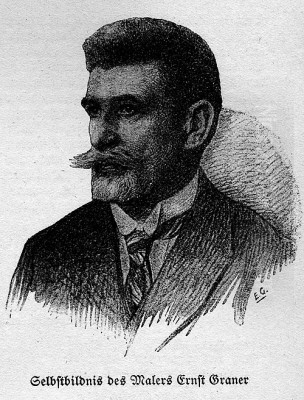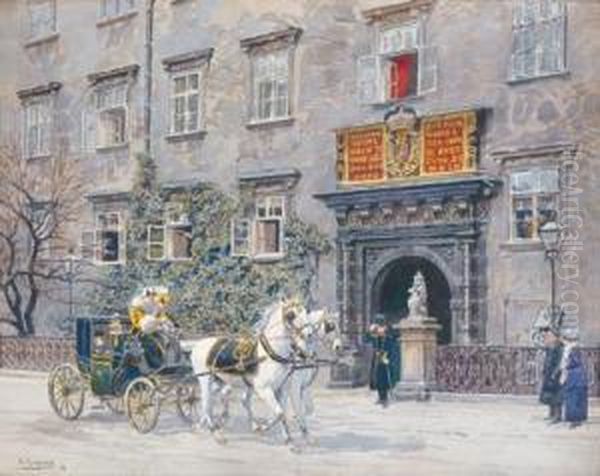
Ernst Graner stands as a significant figure in Austrian art history, particularly renowned for his mastery of watercolour and his evocative depictions of Vienna at the turn of the 20th century. Born in 1865 and passing away in 1943, Graner dedicated much of his artistic career to capturing the architectural beauty, bustling street life, and unique atmosphere of the Habsburg capital. His works serve not only as aesthetically pleasing paintings but also as valuable historical documents of a city undergoing significant transformation.
Early Life and Artistic Formation
Ernst Graner's roots were firmly planted in Vienna, the city that would become his principal muse. Born into the vibrant cultural milieu of the Austro-Hungarian Empire, his initial artistic inclinations led him towards practical crafts. He received early training as a goldsmith and also explored the techniques of lithography, skills which likely honed his eye for detail and precision. Further foundational instruction in drawing came under the tutelage of Josef Grandner, laying the groundwork for his later, more specialized artistic pursuits.
Recognizing his potential, Graner sought formal education at the prestigious Vienna Academy of Fine Arts (Akademie der bildenden Künste Wien). This institution was a crucible of artistic talent, having nurtured generations of Austrian artists. During his time at the Academy, Graner specialized in landscape painting, studying under the guidance of Eduard von Lichtenfels. Lichtenfels, himself a respected landscape painter, would have imparted the academic traditions and techniques essential for capturing nature and the built environment, influencing Graner's approach to composition and representation.
Vienna as the Central Subject
Upon completing his studies, Graner focused his artistic energies primarily on genre scenes and landscape painting, with a distinct emphasis on architectural vedute, particularly those of Vienna. He developed an intimate relationship with the city, exploring its grand boulevards, hidden alleyways, magnificent palaces, and public squares. His works capture iconic landmarks such as the Hofburg Palace, the sprawling former imperial residence, and the magnificent Vienna State Opera (Wiener Staatsoper), a symbol of the city's rich musical heritage.

Graner's paintings go beyond mere topographical accuracy. He possessed a remarkable ability to infuse his watercolours with the life and spirit of the city. He depicted not just the stone and mortar of the buildings but also the daily ebb and flow of Viennese life – carriages traversing cobblestone streets, figures strolling along the Ringstrasse, the interplay of light and shadow on ornate facades. His work provides a window into the Vienna of the late 19th and early 20th centuries, an era of immense cultural flourishing and societal change, preceding the upheavals of war.
Mastery of Watercolour Technique
Watercolour was Graner's preferred medium, and he achieved exceptional proficiency in its use. His technique is characterized by a confident yet delicate touch. Unlike some watercolourists who might strive for intense saturation, Graner's application often appears fluid and natural, allowing the luminosity of the paper to contribute to the overall effect. He demonstrated a keen understanding of the medium's transparency and its capacity for rendering subtle atmospheric effects.
His precision in depicting architectural detail is remarkable. Facades, ornamentation, and structural elements are rendered with clarity, yet without sacrificing the overall artistic impression. This suggests a meticulous process, likely involving careful preliminary sketches. Furthermore, Graner showed a sophisticated sensitivity to light and colour, effectively capturing the changing moods of the city under different weather conditions and times of day. His watercolours often possess a clarity and freshness that remains appealing to contemporary viewers.
Representative Works and Notable Subjects
Among Graner's most celebrated works are his depictions of significant Viennese landmarks. His watercolour of the entrance to the Palais Kinsky on the Freyung, created around 1901-1902, is a prime example of his skill. This painting, now held in the collection of the Belvedere Museum in Vienna, masterfully captures the intricate details of Johann Lukas von Hildebrandt's Baroque architecture, showcasing the play of light on the sculpted portal. It exemplifies his ability to combine architectural accuracy with artistic sensibility.
Other notable subjects included views of the Hofburg complex, various perspectives of the Vienna State Opera, scenes along the Graben and Kohlmarkt, and depictions of St. Stephen's Cathedral. He also documented specific events, such as his watercolour capturing the aftermath of the fire that destroyed the Rotunda in the Vienna Prater, showcasing his ability to record contemporary occurrences. While Vienna was his primary focus, sources also indicate that Graner produced significant works depicting scenes in Venice, another city famed for its beauty and challenging watercolour subjects, following in the footsteps of artists like J.M.W. Turner or Francesco Guardi, albeit with his own distinct style.
Career Trajectory and Recognition
Ernst Graner began establishing his reputation in the Viennese art world around 1890, the year he started participating in exhibitions. His talent was recognized, and he became a member of the Vienna Künstlerhaus (Genossenschaft bildender Künstler Wiens), the prominent association of artists in the city. Membership in the Künstlerhaus provided artists with exhibition opportunities and placed them within the mainstream of the Viennese art scene, distinct from the more avant-garde movements emerging at the time.
His participation in exhibitions continued throughout his career. Records indicate his works were shown in a Künstlerhaus exhibition in 1907 and featured in a Vienna Museum exhibition in 1908. This consistent presence in major Viennese exhibitions underscores his standing within the artistic community. While perhaps not as revolutionary as some of his contemporaries, Graner carved out a respected niche for himself as a master of the watercolour veduta, appreciated for his technical skill and his faithful, yet atmospheric, portrayals of the city.
Vienna's Artistic Milieu: Context and Contemporaries
Graner worked during an exceptionally fertile period in Viennese cultural history, often referred to as "Vienna 1900". This era saw the flourishing of groundbreaking movements in music (Gustav Mahler, Arnold Schoenberg), philosophy (Ludwig Wittgenstein), psychology (Sigmund Freud), and, significantly, the visual arts and architecture. While Graner maintained a relatively traditional style focused on realistic depiction, he was contemporary to radical artistic shifts happening around him.
The Vienna Secession, founded in 1897, challenged the conservative establishment represented partly by the Künstlerhaus. Figures like Gustav Klimt, Koloman Moser, and Carl Moll spearheaded this movement, embracing Art Nouveau (Jugendstil) and Symbolism, and paving the way for Expressionism. Architects like Otto Wagner and Josef Hoffmann were reshaping the city's appearance with modern designs. Younger artists like Egon Schiele and Oskar Kokoschka would soon push the boundaries of representation even further, exploring intense psychological states. Graner's work offers a contrast, representing a continuation of the established tradition of cityscape painting, executed with exceptional skill, standing alongside, rather than within, these avant-garde currents. His dedication to watercolour also connects him to a lineage of Austrian artists skilled in the medium, including the earlier master Rudolf von Alt, whose detailed Viennese views set a high standard.
Artistic Influences and Connections
Graner's primary artistic lineage can be traced through his academic training. His studies under Eduard von Lichtenfels grounded him in the principles of landscape painting as taught at the Vienna Academy. Furthermore, the long tradition of veduta painting in Vienna, exemplified by artists like Bernardo Bellotto (Canaletto's nephew) in the 18th century and the aforementioned Rudolf von Alt in the 19th century, undoubtedly provided a rich context for Graner's work. He inherited their focus on architectural accuracy and the depiction of urban life.
While a member of the Künstlerhaus, there is no strong evidence linking Graner directly to specific avant-garde movements like the Vienna Secession or subsequent Expressionist groups. His style remained largely consistent, focused on realistic representation rendered with watercolour finesse. He did not seem to engage with the radical stylistic experiments or the intense psychological explorations of Klimt, Schiele, or Kokoschka. His path was one of refinement within an established genre, rather than revolutionary innovation. He perfected the art of the Viennese watercolour cityscape during a time when other artists were dramatically redefining the very nature of art.
Legacy and Historical Importance
Ernst Graner is regarded as one of the most significant Viennese watercolourists of his time. His extensive body of work provides an invaluable visual record of Vienna during a pivotal era of its history. His paintings capture the grandeur of Imperial Vienna, the charm of its streets and squares, and the specific appearance of buildings before subsequent alterations or wartime damage. For historians and lovers of Vienna, his works offer a detailed and atmospheric glimpse into the past.
His technical mastery of watercolour continues to be admired. The clarity, detail, and atmospheric quality of his paintings ensure their lasting appeal. While perhaps overshadowed in broader art historical narratives by the more revolutionary figures of Viennese Modernism, Graner holds a secure place within the history of Austrian art and specifically within the tradition of cityscape painting. His works are held in important collections, including the Belvedere Museum and the Vienna Museum (Wien Museum), attesting to his enduring significance. He successfully captured the unique character and architectural splendour of Vienna for posterity.
The Artist's Personal Life
Despite his recognized position in the Viennese art scene and the enduring appeal of his work, detailed information about Ernst Graner's personal life, beyond his educational and professional milestones, remains relatively scarce in readily available sources. There are no widely recounted anecdotes, unusual habits, or documented interactions with famous contemporaries that stand out in his biography. His life appears to have been largely dedicated to his meticulous craft and the observation and depiction of his beloved city.
Existing records confirm his identity as an Austrian painter (1865-1943) focused on Vienna and Venice, educated at the Academy, and a member of the Künstlerhaus. There is no indication of involvement in major political events or controversies, such as affiliations with the Nazi regime, which rose to power towards the very end of his life. His legacy rests firmly on his artistic output rather than on a colourful personal history. Similarly, there is no record of him having formally taken on students, suggesting his influence was primarily through his exhibited work rather than direct teaching outside of any potential informal guidance.
Conclusion: Capturing the Soul of Vienna
Ernst Graner dedicated his considerable artistic talent to capturing the essence of Vienna in watercolour. Working meticulously during a period of intense cultural ferment, he chose a path of refinement within the tradition of architectural and cityscape painting. His works stand out for their technical brilliance, detailed observation, and ability to convey the unique atmosphere of the Habsburg capital. He documented its iconic landmarks and everyday scenes with a sensitivity to light and mood that brings the era to life. While not an avant-garde revolutionary like Klimt or Schiele, Graner was a master craftsman whose paintings serve as both beautiful works of art and precious historical records. His legacy is that of a visual poet of Vienna, preserving its turn-of-the-century character with enduring skill and affection.